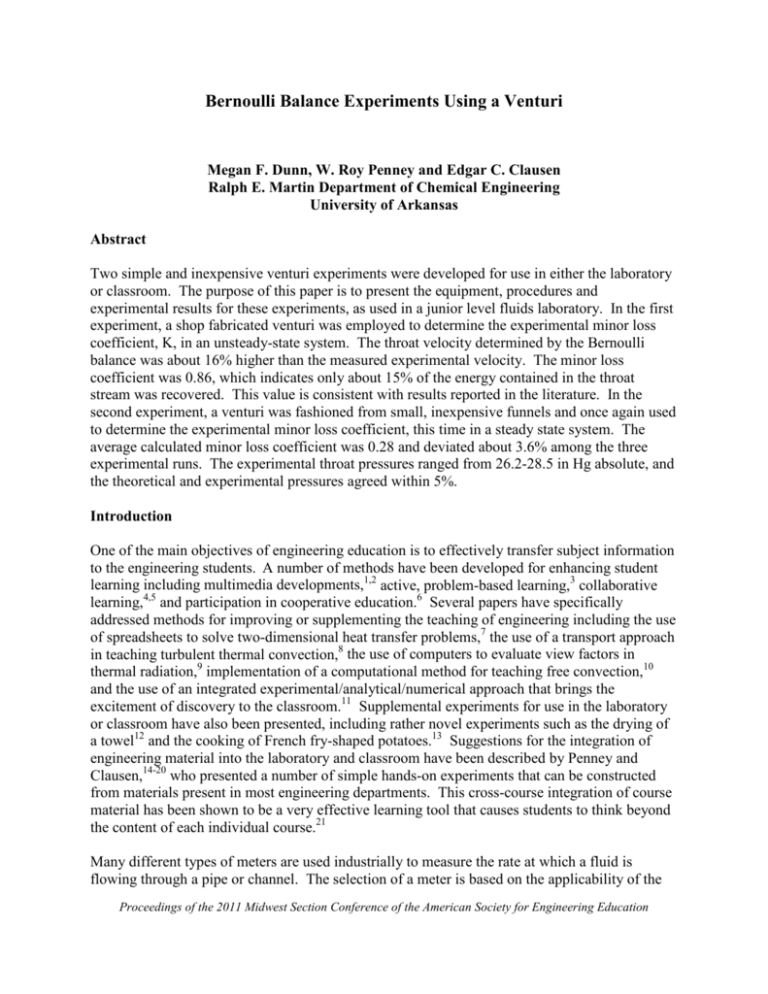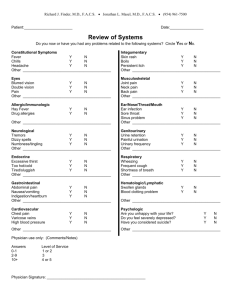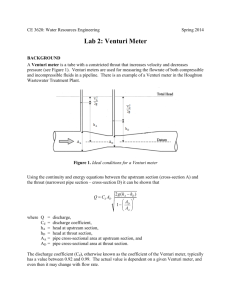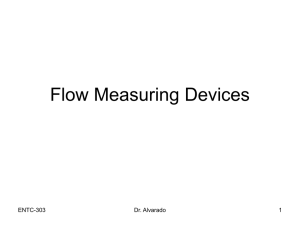Bernoulli Balance Experiments Using a Venturi
advertisement

Bernoulli Balance Experiments Using a Venturi Megan F. Dunn, W. Roy Penney and Edgar C. Clausen Ralph E. Martin Department of Chemical Engineering University of Arkansas Abstract Two simple and inexpensive venturi experiments were developed for use in either the laboratory or classroom. The purpose of this paper is to present the equipment, procedures and experimental results for these experiments, as used in a junior level fluids laboratory. In the first experiment, a shop fabricated venturi was employed to determine the experimental minor loss coefficient, K, in an unsteady-state system. The throat velocity determined by the Bernoulli balance was about 16% higher than the measured experimental velocity. The minor loss coefficient was 0.86, which indicates only about 15% of the energy contained in the throat stream was recovered. This value is consistent with results reported in the literature. In the second experiment, a venturi was fashioned from small, inexpensive funnels and once again used to determine the experimental minor loss coefficient, this time in a steady state system. The average calculated minor loss coefficient was 0.28 and deviated about 3.6% among the three experimental runs. The experimental throat pressures ranged from 26.2-28.5 in Hg absolute, and the theoretical and experimental pressures agreed within 5%. Introduction One of the main objectives of engineering education is to effectively transfer subject information to the engineering students. A number of methods have been developed for enhancing student learning including multimedia developments,1,2 active, problem-based learning,3 collaborative learning,4,5 and participation in cooperative education.6 Several papers have specifically addressed methods for improving or supplementing the teaching of engineering including the use of spreadsheets to solve two-dimensional heat transfer problems,7 the use of a transport approach in teaching turbulent thermal convection,8 the use of computers to evaluate view factors in thermal radiation,9 implementation of a computational method for teaching free convection,10 and the use of an integrated experimental/analytical/numerical approach that brings the excitement of discovery to the classroom.11 Supplemental experiments for use in the laboratory or classroom have also been presented, including rather novel experiments such as the drying of a towel12 and the cooking of French fry-shaped potatoes.13 Suggestions for the integration of engineering material into the laboratory and classroom have been described by Penney and Clausen,14-20 who presented a number of simple hands-on experiments that can be constructed from materials present in most engineering departments. This cross-course integration of course material has been shown to be a very effective learning tool that causes students to think beyond the content of each individual course.21 Many different types of meters are used industrially to measure the rate at which a fluid is flowing through a pipe or channel. The selection of a meter is based on the applicability of the Proceedings of the 2011 Midwest Section Conference of the American Society for Engineering Education 2 instrument to the specific problem, its installed costs and operating costs, the desired range of flow rates and the inherent accuracy of the flow meter.22 In some situations, only a rough indication of the flow rate is required; at other times, highly accurate measurements are necessary to properly control or monitor a process. The venturi meter is one of the more common full-bore meters, i.e. meters that operate by sensing all of the fluid in the pipe or channel. In the operation of a venturi meter, upstream and downstream pressure taps are connected to a manometer or differential pressure transmitter (see Figure 1). This pressure differential is then used to determine the flow rate by applying a Bernoulli balance from the entry of the throat of the meter. The angle of the discharge cone is typically set between 5° and 15° to prevent boundary layer separation and to minimize friction. Typically, 90% of the pressure loss in the upstream cone is recovered, making the venturi very useful for measuring very large flow rates, where power losses can become economically significant. Thus, the higher installed costs of a venturi (over an orifice) are offset by reduced operating costs.22, 23 Figure 1. Venturi Meter Operation The purpose of this paper is to demonstrate two simple and inexpensive laboratory experiments for analyzing the performance of a venturi. These experiments may be performed as laboratory exercises or as classroom demonstrations. In the first experiment, a shop fabricated venturi was employed to determine the experimental minor loss coefficient, K, in an unsteady-state system. In the second experiment, a venturi was fashioned from small, inexpensive funnels and once again used to determine experimental minor loss coefficient, this time in a steady state system. Junior level Chemical Engineering students at the University of Arkansas helped to develop and perform these experiments as part of the requirements for CHEG 3232, Chemical Engineering Laboratory II. Commercial Venturi Experiment The first experiment employed a shop fabricated acrylic venturi (see Figure 2), with a throat 3 diameter of 4.4 mm (16 in) and a pressure tap in the throat. The venturi was assembled in the flow system of Figure 3, consisting of a feed reservoir, an exit reservoir, connecting piping and plastic tubing which served as simple water-filled manometers. Tap water served as the test fluid. Proceedings of the 2011 Midwest Section Conference of the American Society for Engineering Education 3 Figure 2. Photograph of Shop Fabricated Venturi Figure 3. Flow System with Venturi Installed Experimental Procedures To ready the system for operation, the top reservoir was filled to its top mark, and the bottom reservoir was completely filled, such that the exit pipe was submerged as shown in Figure 4. All air was cleared from the system by suctioning. At time zero, the stopper was removed from the bottom of the piping system, and then the time required for the upper reservoir to drain was recorded as the liquid level passed graduated marks. Several additional measurements were made: • The distance from the top of the feed reservoir to the water level • The distance from the top of the feed reservoir to the venturi throat • The distance from the top of the feed reservoir to the water level in the bottom reservoir • The diameter of the feed reservoir Proceedings of the 2011 Midwest Section Conference of the American Society for Engineering Education 4 Figure 4. System Exit in Bottom Reservoir Equipment List • • • • • • • • • Shop fabricated venturi, 1 in NPT fittings, equipped with pressure tap at its throat (45° 3 inlet angle, 30° outlet angle, 4 mm (16 in) throat) Water reservoirs (buckets), 2 3 Copper tubing, 19 mm ( 4 in) od, with fittings 1 Copper tubing, 6 mm ( 4 in) od Rubber stopper 1 Tygon tubing, 12 mm ( 2 in) od Stand for apparatus, as available Garden hose Stopwatch Results and Discussion Table 1 presents experimental data and Figure 5 shows a plot of the height measurements with time as the feed reservoir drained. As is noted in Figure 5, the height in the reservoir decreased linearly with time. Table 1. Measured Heights Distance from Feed Reservoir to . . . Measured Distance, m Water level -1.589 Throat -0.513 Water level in bottom reservoir -1.019 Feed Reservoir Diameter 15.2 cm (6 in) Proceedings of the 2011 Midwest Section Conference of the American Society for Engineering Education 5 0 Height in Reservoir, in -0.5 0 5 10 15 20 25 30 -1 -1.5 y = -0.1595x - 0.1083 R² = 0.9953 -2 -2.5 -3 -3.5 -4 -4.5 Time, s Figure 5. Height Measurements with Time as the Feed Reservoir Drained Data Reduction Experimental Velocity through the Throat The velocity through the throat was calculated by dividing the volumetric flow rate from the feed reservoir by the cross-sectional area of the reservoir. The areas of the feed reservoir and venturi throat were determined as follows: Afr = 2 𝜋𝐷𝑓𝑟 4 𝜋𝐷𝑡2 At = 4 (1) (2) Since the height in the feed reservoir decreased linearly with time, the rate of change may be calculated by the equation 𝑑𝐻 𝑑𝑡 = ∆𝐻 ∆𝑡 (3) The volumetric flow rate from the feed reservoir is then calculated as Q= 𝑑𝐻 𝑑𝑡 Afr (4) Finally, the throat velocity is obtained by 𝑄 vvc = 𝐴 𝑡 (5) Proceedings of the 2011 Midwest Section Conference of the American Society for Engineering Education 6 Throat Velocity from the Bernoulli Balance McCabe et al.22 show the Bernoulli balance (with α terms set to zero) as 𝑃1 𝜌 + gZ1 + 𝑉12 2 𝑃2 +W= 𝜌 + gZ2 + 𝑉22 2 + hf (6) In applying the Bernoulli balance across the manometer, the pressure at the throat is obtained in terms of the elevations, with W and hf both equal to zero. 𝑃𝑚 𝜌 + gHm = 𝑃𝑡 𝜌 + gHt (7) But Pm = 0, because the reference pressure is atmospheric. Thus, 𝑃𝑡 𝜌 = g(Hm – Ht) (8) The Bernoulli balance is now applied from the liquid level in the feed reservoir to the throat, with W = 0 and friction neglected between the feed reservoir and the throat. 𝑃𝑓𝑟 𝜌 + gHfr = 𝑃𝑡 𝜌 + gHt + 𝑉𝑡2 (9) 2 Making use of Equation (8), with Pfr = 0, Equation (9) becomes gHfr = 𝑃𝑡 𝜌 + gHt + 𝑉𝑡2 2 = g(Hm – Ht) + gHt + 𝑉𝑡2 2 (10) But the height in the feed reservoir is the reference point. Thus, vt = (2gHm)1/2 (11) Permanent Friction Loss in the Venturi In applying the Bernoulli balance between the liquid level in the feed reservoir and the liquid level in the discharge reservoir, the following relationship is obtained: hf = gHp (12) The permanent friction loss is normally correlated in terms of the velocity in the throat, i.e., hf = K 𝑉𝑡2 2 (13) where K is the minor loss coefficient for the venturi. Equating Equations (12) and (13) yields K= 2𝑔𝐻𝑝 𝑉𝑡2 (14) Proceedings of the 2011 Midwest Section Conference of the American Society for Engineering Education 7 Discussion of Results Throat Velocity The experimental velocity from Equation (5) is 4.82 m/s and the velocity from the application of the Bernoulli balance (Equation (11)) is 5.58 m/s. The experimental velocity should be less than the Bernoulli balance velocity because the velocity near the venturi walls is lower than the centerline velocity. The experimental velocity is lower than the Bernoulli balance velocity by about 16%. Venturi Minor Loss Coefficient The experimental minor loss coefficient from Equation (14) is 0.86, which indicates that only about 15% of the energy content of the vena contracta stream is recovered. This is a low efficiency, which is a result of the large 30° included angle of the diffuser. Duggins24 found that the pressure recovery efficiency for a 30° included angle conical diffuser was about 0.25 for an area ratio of 3.265 (a diameter ratio of 1.8). The area ratio for the current diffuser was about 0.75𝑖𝑛 � 3 𝑖𝑛 16 2 � = 16. With the flow separation which occurs in a 30° included angle diffuser, the shop fabricated venturi is too long for optimum pressure recovery. Conclusions 1. The throat velocity determined by the Bernoulli balance was about 16% higher than the measured experimental velocity, probably caused by 3 a. the boundary layer effects in the small �16 in� throat, and b. the effect of the jet vena contracta occurring somewhat downstream of the throat of the venturi 2. The minor loss coefficient for the venturi was about 0.86, which indicates only about 14 % of the energy contained in the vena contracta stream was recovered. This value is consistent with results reported in the literature. Funnel Venturi Experiment A venturi experiment was also performed with a “homemade” venturi, fashioned from 3 in diameter plastic funnels. Figure 6 shows a photograph of the supplies used to construct the venturi. Epoxy was used to securely fasten the top funnel into a 3 in hole at the bottom of a bucket. The second funnel was then attached to the first funnel using epoxy with the aid of a 10 cc syringe. Tygon tubing was split and then attached to the ends of each funnel with putty. Hose clamps were also placed on the ends to further secure the tubing. The split in the tube was repaired by using clear packaging tape. A 9.5 mm (0.375 in) tube was placed through the tygon tubing at the throat of the venturi to measure the pressure with a vacuum gauge. A PVC pipe splint and putty were used to support the tube and keep it straight. Proceedings of the 2011 Midwest Section Conference of the American Society for Engineering Education 8 Figure 6. Supplies Used in Preparing a Funnel Venturi Experimental Procedures The experimental set-up for the funnel venturi system was slightly different from the procedures used with the commercial venturi (see Figure 7), primarily in the use of a vacuum gauge to measure pressure in the throat and the use of a constant level feed reservoir (operation at steady state). Figure 8 shows a close-up of the pressure tap at the throat. To begin the experiment, the feed and bottom reservoirs (buckets) were filled to the top with tap water. The water flow from the tap was adjusted to keep the height of the water in the feed reservoir constant. Once the system was operating at steady state, the distance from the water level in the feed reservoir to the water level in the bottom reservoir was measured, and the pressure at the throat of the venturi was recorded. The flow rate of water was determined by diverting the feed hose into a reservoir (bucket) for a measured time period. This procedure was repeated at two additional flow rates. Equipment List • • • • • • • • • Funnels, 2, 76.2 mm (3 in) top diameter, 10 mm (0.3855 in) nozzle diameter Water reservoirs (buckets), 3 Balance Epoxy Plumber’s putty Duct tape Packaging tape Electrical tape Syringe, 10 cc, to disperse epoxy Proceedings of the 2011 Midwest Section Conference of the American Society for Engineering Education 9 • • • • • • • • • 1 ½ in PVC pipe splint Hose clamps 3 Tygon tubing, 35 mm (1 8 in) od 1 Copper tubing, 6 mm ( 4 in) Syphon Stand for apparatus, as available Vacuum gauge, 0-30 in Hg Garden hose Stopwatch Figure 7. Flow System with Venturi Figure 8. Close-up of Venturi Tap at the Throat Experimental Data The data from the three experimental runs are presented in Table 2. The units are mixed (SI, English units) because they represent the actual experimental data taken in the laboratory. As expected, the vacuum in the vena contract increased as the the flow rate of water increased. Run 1 2 3 Table 2. Experimental Data from the Funnel Venturi Experiment Pt, Hp, m Water Collected, Time for in Hg (gauge) lbm Collection, s 3.7 -0.560 44.5 39.79 3.0 -0.495 45.5 49.24 1.4 -0.307 43.0 55.16 Proceedings of the 2011 Midwest Section Conference of the American Society for Engineering Education 10 Data Reduction Experimental Velocity through the Throat The velocity in the throat is once again found using Equation (5) 𝑄 vt = 𝐴 (5) 𝑡 However, in these steady state experiments, the volumetric flow rate is found by the equation 𝑄= 𝑚𝜌 (15) 𝑡 Permanent Friction Loss in the Venturi The minor loss coefficient for the venturi is once again found by the equation K= 2𝑔𝐻𝑝 (14) 𝑉𝑡2 Bernoulli Balance to Find Throat Pressure A Bernoulli balance may be written for the system between the top of the feed reservoir and the throat of the venturi: 𝑃𝑓𝑟 𝜌 + 𝑔𝐻𝑓𝑟 = 𝑃𝑡 𝜌 + 𝑔𝐻𝑡 + 𝑉𝑡2 (16) 2 After rearrangement, the theoretical pressure in the throat can be calculated using the equation 𝑝𝑡 = 𝜌 � 𝑃𝑓𝑟 𝜌 + 𝑔�𝐻𝑓𝑟 − 𝐻𝑡 � − 𝑉𝑡2 2 � (17) The experimental absolute pressure in the throat can be found by subtracting the vacuum gauge pressure from atmospheric pressure. Comparisons can then be made between the theoretical and experimental pressures. Discussion of Results Table 3 shows results for the velocity in the throat vena contracta, the minor loss coefficient, and experimental and theoretical throat pressures for the three experimental runs. The calculated velocities were 6.72, 5.56 and 4.69 m/s, for the three experimental runs. The calculated minor loss coefficients were 0.25, 0.31 and 0.27. Although the coefficient was not constant for the three runs as expected, the percent deviation for these values was only 3.5%, an acceptable experimental error. The experimentally obtained throat pressures for each flow rate were 26.22, 26.92 and 28.52 in Hg, and the theoretical throat pressures calculated from experimental velocities were 25.02, 26.93 and 27.69 in Hg. The theoretical and experimental pressures for each data point agreed within 5%, again an acceptable experimental error. Proceedings of the 2011 Midwest Section Conference of the American Society for Engineering Education 11 Table 2. Reduced Results from the Experiments vt (m/s) K Pt, in Hg abs Experimental Theoretical 6.72 0.25 26.22 25.02 5.56 0.31 26.92 26.93 4.69 0.27 28.52 27.69 Run 1 2 3 Conclusions 1. The calculated minor loss coefficients were 0.25, 0.31 and 0.27, a scatter of 3.6%. 2. The experimentally obtained throat pressures for each flow rate were 26.22, 26.92 and 28.52 in Hg, while the theoretical throat pressures based on experimental velocities were 25.02, 26.93 and 27.69 in Hg. The theoretical and experimental pressures agreed within 5%. Nomenclature Afr At Dfr Dt H Hfr Hm Hp Ht K P1 P2 Pfr, Pm Pt Q v1 v2 vt W Z1 Z2 𝑑𝐻 𝑑𝑡 g hf m t Δ Area of feed reservoir, m2 Area of throat, m2 Diameter of feed reservoir, m Diameter of throat, m Height, m Height of liquid in the feed reservoir, m Distance from the top of the feed reservoir to the water, m Distance from the top of the feed reservoir to the water in the bottom reservoir, m Distance from the top of the feed reservoir to the throat Minor loss coefficient for the venture, dimensionless Pressure at position 1, atm Pressure at position 2, atm Pressure at manometer entrance, (Pfr = Pm = atmospheric pressure) Pressure in throat, atm Volumetric flow rate from feed reservoir, m3/s Velocity at position 1, m/s Velocity at position 2, m/s Velocity in throat, m/s Work done on/by the system, m2/s2 Height at position 1, m Height at position 2, m Height change in the feed reservoir with time, m/s Acceleration of gravity, m/s2 friction in the system, m2/s2 Mass of collected water, kg Time, s Change in . . . Proceedings of the 2011 Midwest Section Conference of the American Society for Engineering Education 12 ρ Fluid (water) density, kg/m3 Bibliography 1. Ellis, T., 2004, “Animating to Build Higher Cognitive Understanding: A Model for Studying Multimedia Effectiveness in Education,” Journal of Engineering Education, Vol. 93, No. 1, pp. 59-64. 2. Wise, M., Groom, F.M., 1996, “The Effects of Enriching Classroom Learning with the Systematic Employment of Multimedia” Education, Vol. 117, No. 1, pp. 61-69. 3. Grimson, J., 2002, “Re-engineering the Curriculum for the 21st Century,” European Journal of Engineering Education, Vol. 27, No. 1, pp. 31-37. 4. Bjorklund, S.A., Parente, J.M., Sathianathan, D., 2004, “Effects of Faculty Interaction and Feedback on Gains in Student Skills,” Journal of Engineering Education, Vol. 93, No. 2, pp. 153-160. 5. Colbeck, C.L., Campbell, S.E., Bjorklund, S.A., 2000, “Grouping in the Dark: What College Students Learn from Group Projects,” Journal of Engineering Education, Vol. 71, No. 1, pp. 60-83. 6. Blair, B.F., Millea, M., Hammer, J., 2004, “The Impact of Cooperative Education on Academic Performance and Compensation of Engineering Majors,” Journal of Engineering Education, Vol. 93, No. 4, pp. 333-338. 7. Besser, R.S., 2002, “Spreadsheet Solutions to Two-Dimensional Heat Transfer Problems.” Chemical Engineering Education, Vol. 36, No. 2, pp. 160-165. 8. Churchill, S.W., 2002, “A New Approach to Teaching Turbulent Thermal Convection,” Chemical Engineering Education, Vol. 36, No. 4, pp. 264-270. 9. Henda, R., 2004, “Computer Evaluation of Exchange Factors in Thermal Radiation,” Chemical Engineering Education, Vol. 38, No. 2, pp. 126-131. 10. Goldstein, A.S., 2004, “A Computational Model for Teaching Free Convection,” Chemical Engineering Education, Vol. 38, No. 4, pp. 272-278. 11. Olinger, D.J., Hermanson, J.C., 2002, “Integrated Thermal-Fluid Experiments in WPI’s Discovery Classroom,” Journal of Engineering Education, Vol. 91, No. 2, pp. 239-243. 12. Nollert, M.U., 2002, “An Easy Heat and Mass Transfer Experiment for Transport Phenomena,” Chemical Engineering Education, Vol. 36, No. 1, pp. 56-59. 13. Smart, J.L., 2003, “Optimum Cooking of French Fry-Shaped Potatoes: A Classroom Study of Heat and Mass Transfer,” Chemical Engineering Education, Vol. 37, No. 2, pp. 142-147, 153. 14. Clausen, E.C., Penney, W.R., Marrs, D.C., Park, M.V., Scalia, A.M., N.S. Weston, N.S., 2005, “Laboratory/Demonstration Experiments in Heat Transfer: Thermal Conductivity and Emissivity Measurement,” Proceedings of the 2005 American Society of Engineering Education-Gulf Southwest Annual Conference. 15. Clausen, E.C., Penney, W.R., Dorman, J.R., Fluornoy, D.E., Keogh, A.K., Leach, L.N., 2005, “Laboratory/Demonstration Experiments in Heat Transfer: Laminar and Turbulent Forced Convection Inside Tubes,” Proceedings of the 2005 American Society of Engineering Education-Gulf Southwest Annual Conference. 16. Clausen, E.C., Penney, W.R., Colville, C.E., Dunn, A.N., El Qatto, N.M., Hall, C.D., Schulte, W.B., von der Mehden, C.A., 2005, “Laboratory/Demonstration Experiments in Heat Transfer: Free Convection,” Proceedings of the 2005 American Society of Engineering Education-Midwest Section Annual Conference. 17. Clausen, E.C., Penney, W.R., Dunn, A.N., Gray, J.M., Hollingsworth, J.C., Hsu, P.T., McLelland, B.K., Sweeney, P.M., Tran, T.D., von der Mehden, C.A., Wang, J.Y., 2005, “Laboratory/Demonstration Experiments in Heat Transfer: Forced Convection,” Proceedings of the 2005 American Society of Engineering Education-Midwest Section Annual Conference. 18. Clausen, E.C., Penney, W.R., 2006, “Laboratory Demonstrations/Experiments in Free and Forced Convection Heat Transfer,” Proceedings of the 2006 American Society for Engineering Education Annual Conference and Exposition. 19. Penney, W.R., Lee, R.M., Magie, M.E. and Clausen, E.C., 2007, “Design Projects in Undergraduate Heat Transfer: Six Examples from the Fall 2007 Course at the University of Arkansas,” Proceedings of the 2007 American Society of Engineering Education Midwest Section Annual Conference. Proceedings of the 2011 Midwest Section Conference of the American Society for Engineering Education 13 20. Penney, W.R., Brown, K.J., Vincent, J.D. and Clausen, E.C., 2008, “Solar Flux and Absorptivity Measurements: A Design Experiment in Undergraduate Heat Transfer,” Proceedings of the 2008 American Society of Engineering Education Midwest Section Annual Conference. 21. Birol, G., Birol, Í., Çinar, A., 2001, “Student-Performance Enhancement by Cross-Course Project Assignments: A Case Study in Bioengineering and Process Modeling,” Chemical Engineering Education, Vol. 35, No. 2, pp. 128-133. 22. McCabe, W.L., Smith, J.C.,Harriott, P., 2005, Unit Operations of Chemical Engineering, 7th edition, McGraw-Hill Book Companies, Inc., New York, NY. 23. Green, D.W., Editor-in-Chief, 2008, Perry’s Chemical Engineering Handbook, 8th edition, McGraw-Hill Book Companies, Inc., New York, NY. 24. Duggins, R. K., 1977, “Some Techniques for Improving the Performance of Short Conical Diffusers” 6th Australian Hydraulics and Fluid Mechanics Conference, Adelaide, Australia, (www.mech.unimelb.edu.au/people/staffresearch/.../6/Duggins.pdf). Biographical Information MEGAN F. DUNN Ms. Dunn is currently a senior (a junior when the lab work was performed) in Chemical Engineering at the University of Arkansas. Her lab report in CHEG 3232 was selected as the source of material for this paper. W. ROY PENNEY Dr. Penney currently serves as Professor of Chemical Engineering at the University of Arkansas. His research interests include fluid mixing and process design, and he has been instrumental in introducing hands-on concepts into the undergraduate classroom. Professor Penney is a registered professional engineer in the state of Arkansas. EDGAR C. CLAUSEN Dr. Clausen currently serves as Professor, Associate Department Head and the Ray C. Adam Endowed Chair in Chemical Engineering at the University of Arkansas. His research interests include bioprocess engineering, the production of energy and chemicals from biomass and waste, and enhancement of the K-12 educational experience. Professor Clausen is a registered professional engineer in the state of Arkansas. Proceedings of the 2011 Midwest Section Conference of the American Society for Engineering Education







